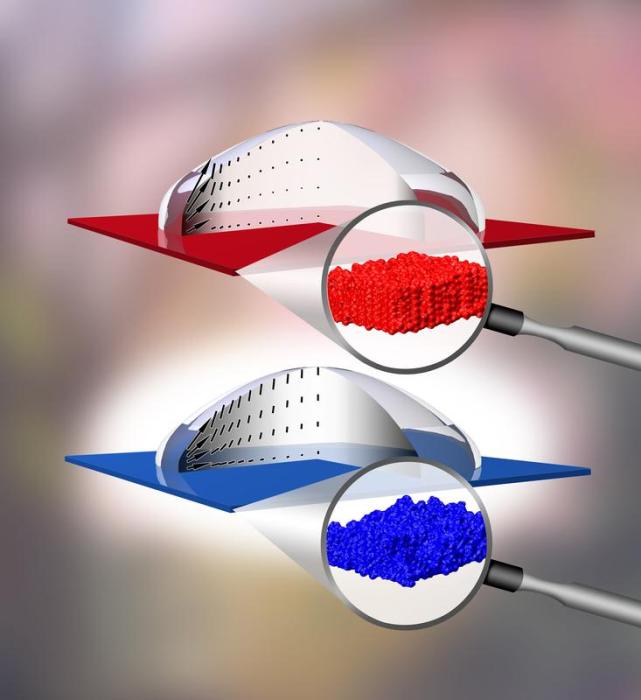Feb 11 2016
It is possible to make liquids slide over a solid surface, similar to a bobsleigh on ice, as discovered in research conducted by physicists from Saarland University and the ESPCI in Paris. A coating applied at the boundary between the solid surface and the liquid induces the liquid to slide through. The sliding effect increases the liquid’s average flow velocity and its throughput. The effect was demonstrated by examining the behavior of liquid droplets on solid surfaces with various types of coatings as they attained the equilibrium state. The results of the research could be helpful to optimize industrial processes, such plastic extrusion. The study has been published in the well-known academic journal, Proceedings of the National Academy of Sciences of the United States of America (PNAS).
 Polystyrene droplets on two different substrates slowly adopt the same equilibrium contact angle, but the velocity and flow profiles of the molecules in the droplets are different in the two cases. (Illustration: Thomas Braun, Heidelberg)
Polystyrene droplets on two different substrates slowly adopt the same equilibrium contact angle, but the velocity and flow profiles of the molecules in the droplets are different in the two cases. (Illustration: Thomas Braun, Heidelberg)
During flow of liquid over a solid surface, the flow velocity proximal to the surface is zero.
By specially coating the surface, the boundary layer velocity can be increased. This also has the effect of reducing the shear forces within the liquid and of increasing its mean flow velocity. In the extreme case, the liquid behaves almost like a solid, but without exhibiting any change in its viscosity.
Karin Jacobs, Professor of Experimental Physics, Saarland University.
The research team is conducting experiments involving polystyrene (PS) droplets, to reveal the details of how various surfaces influence the boundary layer velocities and the sliding behavior of liquid films.
Polystyrene is an important polymer that is used, for instance, to manufacture CD jewel cases.
Dr. Joshua D. McGraw, Former Postdoc
The research was a collaborative effort with members of the research team led by Ralf Seemann, Professor of Experimental Physics at Saarland University, and researchers at ESPCI Paris Tech.
When droplets of polystyrene were placed on thin mica surfaces, they flattened out in sizes over a thousand times smaller than a usual rain drop. The droplets were frozen in this condition, and were then transferred onto two ‘less PS-friendly’ substrates, where each substrate had a different spatial atom arrangement. The droplets took an almost hemispherical shape on both substrates.
Droplets always show a tendency to adopt an equilibrium form in which they exhibit a definite contact angle to the surface. This equilibrium state is determined by the boundary layer conditions
Karin Jacobs, Professor of Experimental Physics, Saarland University
Polystyrene droplet profile measurements, conducted by utilizing an atomic force microscope, showed considerable differences in droplets contraction, changing from their initial shape with a smaller contact angle to the subsequent hemispherical form, although the droplets had the same equilibrium contact angle on both substrates.
“This can only mean that the molecules in the droplets move in two different ways on the two different surfaces, which in turn means that the velocity profiles in the two drops must be different,” say Dr. Martin Brinkmann and Dr. Tak Shing Chan from Ralf Seemann’s group. “However, the required resolution is not available experimentally. That’s why we needed the support of the theoreticians in Paris.”
The velocity of the liquid at the surface of the solid is an important factor affecting the flow behavior of small droplets, according to the conclusion arrived at by the Saarbrücken researchers. This effect was incorporated into a theoretical model of fluid dynamics by the research team at ESPCI Paris. Martin Brinkmann and Tak Shing Chan used the theoretical description to perform computer simulations, which yielded the molecular velocity field inside a liquid drop.
“This enabled us to demonstrate that even atomic-scale modifications to a solid surface can alter the speeds with which molecules move in liquid systems that are many orders of magnitude thicker than the surface coating itself,” says Professor Jacobs, summarizing the results of the experiments.
The results can help in the optimization of industrial processes including extrusion of polymeric materials. Once the dough has passed through the forming die, the strand expands as the material is now flowing more slowly. This expansion of the material as it exits the die (known as “die swell”) is usually undesirable in industrial applications, but it may be possible to suppress die swell by suitably coating the inner surfaces of the die.
Karin Jacobs, Professor of Experimental Physics, Saarland University.